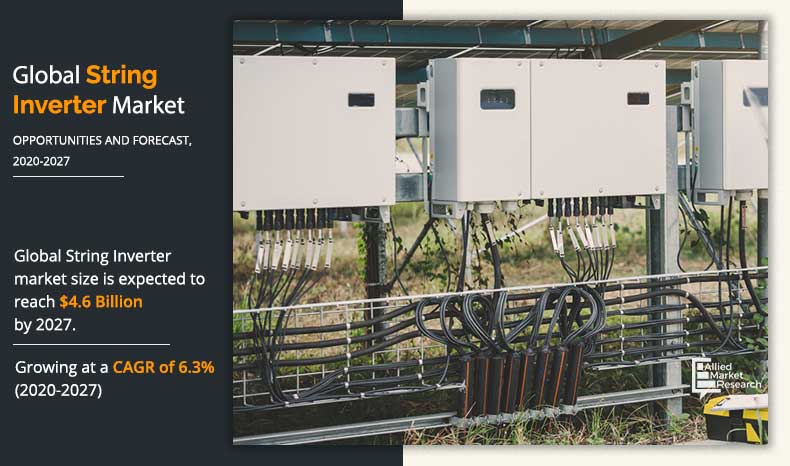
According to a new report published by Allied Market Research titled, “String Inverter Market by Connection Type, Phase, and End-Use Industry: Global Opportunity Analysis and Industry Forecast, 2020–2027,” the global string inverter market size was valued at $3.1 billion in 2019, and is projected to reach $4.6 billion by 2027, growing at a CAGR of 6.3% from 2020 to 2027.
Significant development of the end-use industries such as oil & gas, telecom, mining, pharmaceutical, chemicals, and healthcare is fueling the demand for off–grid solar installations for their respective manufacturing and operations, which in turn drives the growth of the market during the forecast period. In addition, increase in demand for string inverter from developing economies such as India, China, and Japan fuels the growth of the market, globally. However, high heat generation from large size string inverters and installation of solar panels in different directions are the key factors hampering the growth of the global market in the upcoming years.
Download Sample PDF @https://www.alliedmarketresearch.com/request-sample/6891
Depending on the connection type, on-grid segment held the highest market share of around 60.3% in 2019, and is expected to maintain its dominance during the forecast period. This is owing to rise in investment for direct supply of electricity rather than storing it in batteries. In addition, advantages of being used as on-grid string inverters include easy feeding of energy, easy installation, cost-efficiency, and managing high electricity demand, which fuels the growth of the market in the upcoming years.
On the basis of phase, the three phase segment holds the largest market share of 76.4% and growth rate of 6.4%, in terms of revenue, and is expected to maintain its dominance during the forecast period. This growth is attributed to the gaining importance from power generation, distribution, and transmission sector. In addition, rise in trend from 1,000-volt solar arrays to 1,500-volt solar arrays resulted in increase in size of PV power plants in the large commercial and utility installations; thereby, fueling the growth of the three-phase string inverter market during the forecast period.
On the basis of end use industry, the utilities segment holds the largest share, in terms of revenue, and is expected to grow at a CAGR of 6.6%. This is attributed to increase in investment in the utility scale solar power plants, solar parks, and other solar structures. In addition, increase in construction projects such as decentralized solar power plants, rural electrification projects, solar power plants on the water body and rooftops, commercial buildings, and others drive the growth of the market for the utilities segment across the globe.
On the basis of region, the market is analyzed across four major regions such as North America, Europe, Asia-Pacific, and LAMEA. Asia-Pacific garnered the dominant share in 2019, and anticipated to maintain this trend during the forecast period. This is attributed to large number of key players and availability of the manufacturing facilities in these countries. In addition, rise in urbanization and industrialization in the countries such as China, India, and others is increasing the demand for electricity, which further drives the growth of the string inverter market during the forecast period.
For Enquiry @https://www.alliedmarketresearch.com/purchase-enquiry/6891
The global string inverter market analysis covers in-depth information of the major industry participants. The key players operating and profiled in the report include SMA Technologies AG, FimerS.p.A., SolarEdge Technologies Ltd., Ginlong Technologies, Siemens AG, Delta Electronics Public Co., Ltd., Chint Group, SolarMax, Growatt New Energy Technology Co., Ltd., and Huawei Technologies Co., Ltd.
Key Findings of the Study:
• The on-grid segment accounted for majority of the share of the global string inverter market, and is expected to maintain its lead throughout the forecast period.
• The three phase segment accounted for around 76.4% of the share in the global string inverter market, and is expected to maintain its dominance till the end of the forecast period.
• The utilities segment is accounted for 40.4% market share, and is anticipated to grow at a rate of 6.6% in terms of revenue, increasing its share in the global string inverter market.
• Utilities are the fastest-growing end-use industry segment in the Asia-Pacific string inverter market, which is expected to grow at a CAGR of 6.8% during 2020–2027.
• The Asia-Pacific region is expected to grow at the fastest rate, registering a CAGR of 6.5%, throughout the forecast period.
• Asia-Pacific dominated the global string inverter market with more than 50.0% of the share, in terms of revenue.
Get detailed COVID-19 impact analysis on the Market @https://www.alliedmarketresearch.com/request-for-customization/6891?reqfor=covid
About Us
Allied Market Research (AMR) is a full-service market research and business-consulting wing of Allied Analytics LLP based in Portland, Oregon. Allied Market Research provides global enterprises as well as medium and small businesses with unmatched quality of “Market Research Reports” and “Business Intelligence Solutions.” AMR has a targeted view to provide business insights and consulting to assist its clients to make strategic business decisions and achieve sustainable growth in their respective market domain.
We are in professional corporate relations with various companies and this helps us in digging out market data that helps us generate accurate research data tables and confirms utmost accuracy in our market forecasting. Allied Market Research CEO Pawan Kumar is instrumental in inspiring and encouraging everyone associated with the company to maintain high quality of data and help clients in every way possible to achieve success. Each and every data presented in the reports published by us is extracted through primary interviews with top officials from leading companies of domain concerned. Our secondary data procurement methodology includes deep online and offline research and discussion with knowledgeable professionals and analysts in the industry.